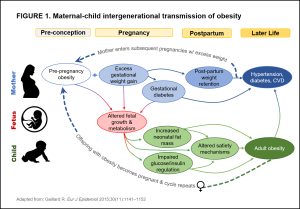A growing body of evidence indicates that obesity has a detrimental impact on reproductive potential in women. In addition to reduced fertility, maternal pre-pregnancy body mass index (BMI), excessive gestational weight gain, and postpartum weight retention are collectively associated with adverse fetal development, obstetric complications, and long-term health outcomes for mothers and their offspring.
Relative to women with a healthy pre-pregnancy BMI (18.5 ≤ BMI < 25 kg/m2), women with obesity at conception were 3.5 times more likely to have miscarriages, 3.2 times more likely to develop preeclampsia, 2.8 times more likely to experience stillbirth, and 2.6 times more likely to develop gestational diabetes. Regardless of a woman’s pre-pregnancy BMI, excessive gestational weight gain (GWG) poses similar increases in the likelihood of developing gestational diabetes and can increase the mother's risk of postpartum weight retention and developing or exacerbating obesity. On average, GWG declines as pre-pregnancy BMI increases, with an estimated 9-16% of women with obesity weighing less at delivery than at conception. However, women with obesity at conception also have higher odds of excessive GWG compared to those with a BMI in the normal range.
Maternal obesity at conception and excessive GWG are associated with maladaptive fetal programming that leads to short- and long-term adverse cardiovascular and metabolic health outcomes in the offspring, effectively perpetuating the intergenerational transmission of obesity (Figure 1). Mechanisms underlying these associations are complex, proceeding through several pathways that involve epigenetic modifications, increased placental nutrient transfer, and fetal adaptations—e.g. increased insulin and leptin synthesis, increased intrauterine growth and fat deposition, and altered hypothalamic development. Because family sociodemographic, lifestyle, and genetic factors may mediate or moderate the association between maternal adiposity and adverse offspring health outcomes, sophisticated sibling comparison studies and randomized control trials are needed to assess causality. Improved understanding of these mechanisms will help to inform updated guidelines and effective interventions around pregnancy-related weight change.
Excessive GWG also increases the likelihood of postpartum weight retention (PPWR)—the difference between a woman’s body weight one year after delivery and her pre-pregnancy weight. A recent study of predominantly low-income women found that approximately 75% of participants experienced postpartum weight retention, with 47% retaining over 10 lbs and 24% retaining over 20 lbs. Thirty-two percent of women who had pre-pregnancy BMIs in the normal range were overweight or had obesity at 1-year postpartum. Among women with pre-pregnancy BMIs in the overweight range, 44% had obesity at 1-year postpartum. These data suggest that PPWR is a likely driver of excessive weight gain during young adulthood and implicates the postpartum period as an important window of opportunity for high-intensity obesity interventions.
Environments that enable women of childbearing age to achieve and maintain a healthy weight before, during, and after pregnancy can improve the health trajectories of Americans in the present and for generations to come. Although preventing or reducing obesity prior to conception is the single best strategy for decreasing the health burden associated with maternal obesity, pregnancy is an ideal time to integrate new healthy habits that dramatically improve maternal/child health for future pregnancies and weight-related health outcomes in later life. Unfortunately, interventions that effectively prevent excessive gestational weight gain and minimize postpartum weight retention are lacking. Research funding to develop engaging, economically-feasible programs that can be delivered in routine care settings and policies that improve access to weight management supports during the postpartum period constitute important areas for improvement.



